What is a Gate valve?
A Gate valve is a fitting that fully opens or closes the flow in pipelines. It operates with a wedge-shaped shut-off element and is used exclusively in the open or closed position, as intermediate positions can lead to material wear.
Wedge flat valve / Wedge oval valve / Wedge round valve
The designations wedge flat, wedge oval, and wedge round gate valves originate from the early days of valve construction. They refer, on one hand, to the total lengths: wedge flat gate valves have a significantly shorter (= flat) total length than wedge oval or wedge round gate valves. In the past, they could only be manufactured for the low-pressure range in PN 6 up to a maximum of PN 10. Today, this is possible for the water and wastewater sector up to PN 25.
On the other hand, wedge oval and wedge round gate valves are named according to their housing design. From a top view, wedge oval gate valves have an oval-shaped top part, while wedge round gate valves have a round one. The initially available wedge oval gate valves were produced for the medium pressure range of PN 10 and PN 16/25. In the higher pressure stages, from PN 25 upwards, the gate top had to be designed more robustly, which is why the usual oval shape was deviated from and a round top was adopted.
The sealing of these valves is achieved using a wedge-shaped shut-off element – hence the name wedge valve. (see also types of shut-off wedges)
Wedge valves can, due to their design, be flowed through in both directions and are sealing on both sides. However, they are not suitable for regulation and are used only as shut-off valves in open or closed position (On/Off). In intermediate positions, the sealing wedge begins to flutter, causing turbulence and increased material wear on the wedge, housing, and sealing surfaces.
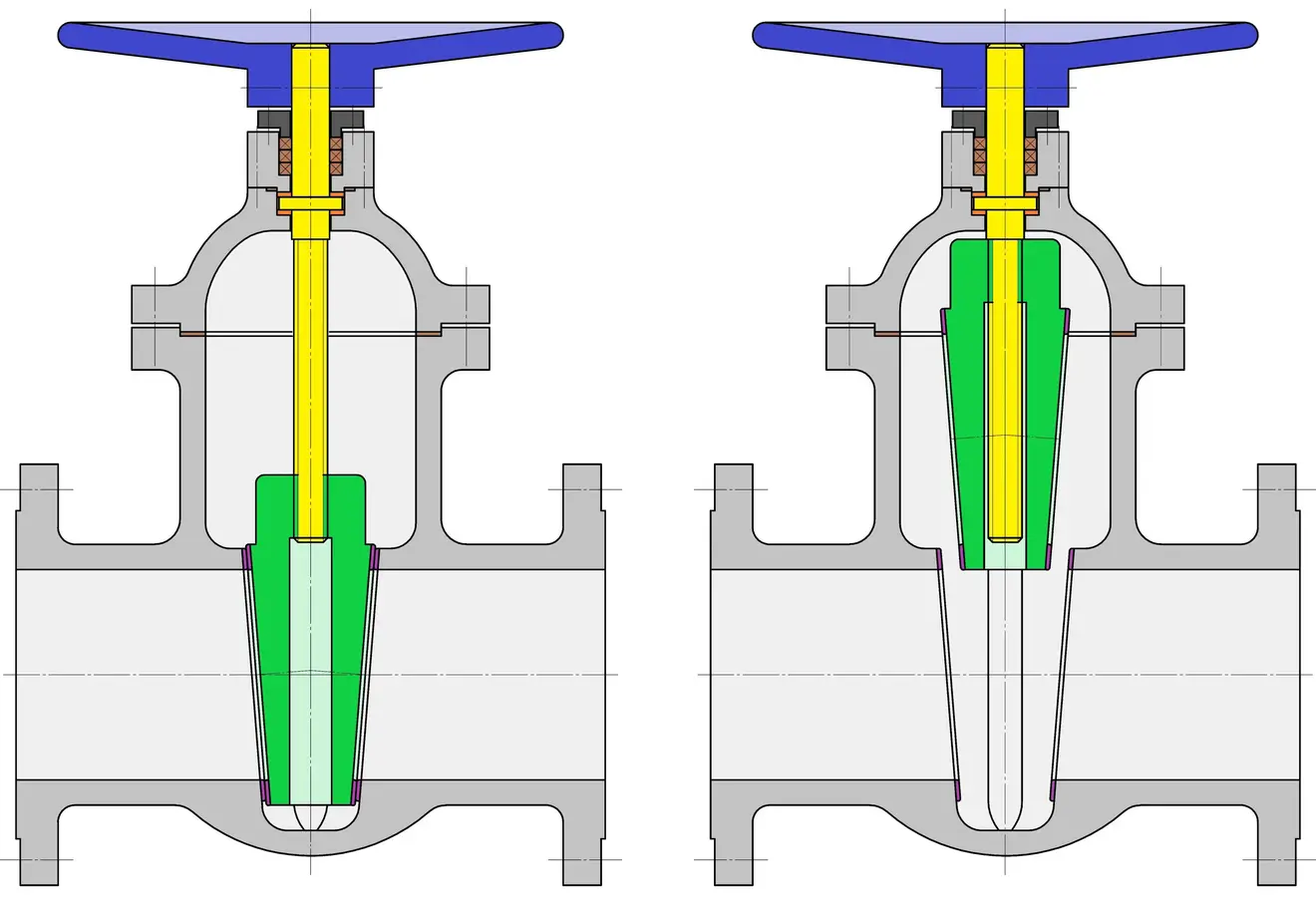
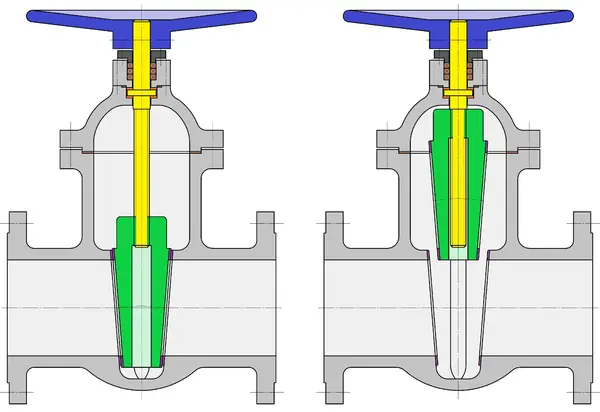
Gate valve
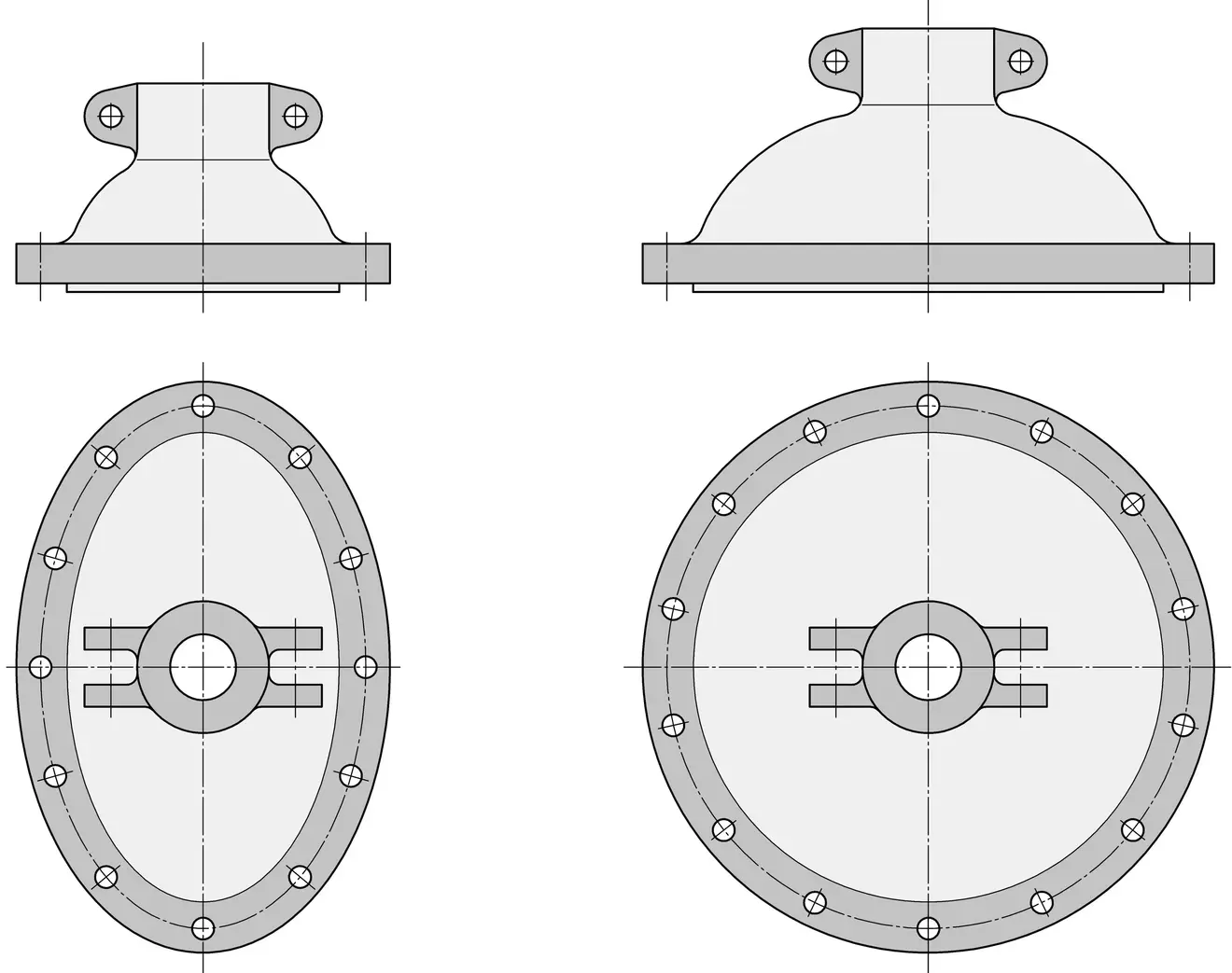
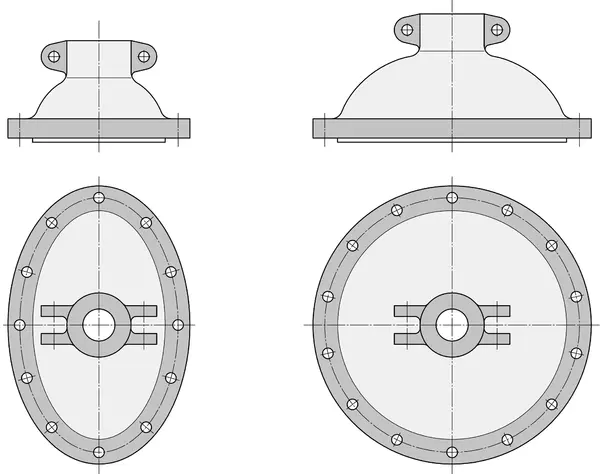
Oval design Circular design
Internal / external spindle


Internal (non-rising) spindle,
with metallic sealing
Internal Spindle
Today, sliders with an internal spindle are most commonly used, where the threaded part of the spindle is situated in the slider housing. This compact design allows for a low upper part and manufacturing is more cost-effective than for sliders with an external spindle.
When the spindle is actuated, it rotates into the thread of the gate wedge. This pulls the gate wedge upwards into the upper part of the slider and opens the slider. By rotating in the opposite direction, the slider is closed again.
The spindle sealing can optionally be achieved via an adjustable stuffing box or through several O-rings that are virtually maintenance-free.
Gate valves with an internal spindle are only suitable for non-aggressive liquids and gases. Because the spindle thread is in the media flow, the use of aggressive media can lead to contamination and subsequent "seizing" of the thread.
External spindle
In valves with an external spindle, the threaded part of the valve rod is not inside the housing but is located at the top, outside the valve upper part. The smooth area of the spindle is located within the housing and is form-fit connected to the valve wedge. The spindle nut is mounted in the so-called block attachment above the valve housing. When the valve is operated, the spindle nut is rotated, "pulling" the spindle, including the wedge, upwards, and the valve is opened.
The advantage over valves with an internal spindle is that they are also suitable for aggressive media. Both the spindle thread and the spindle sealing (packing) are outside the flow of the media, which means that "seizing" of the spindle thread is almost excluded.
The position of the spindle can also quickly indicate whether the valve is open or closed.
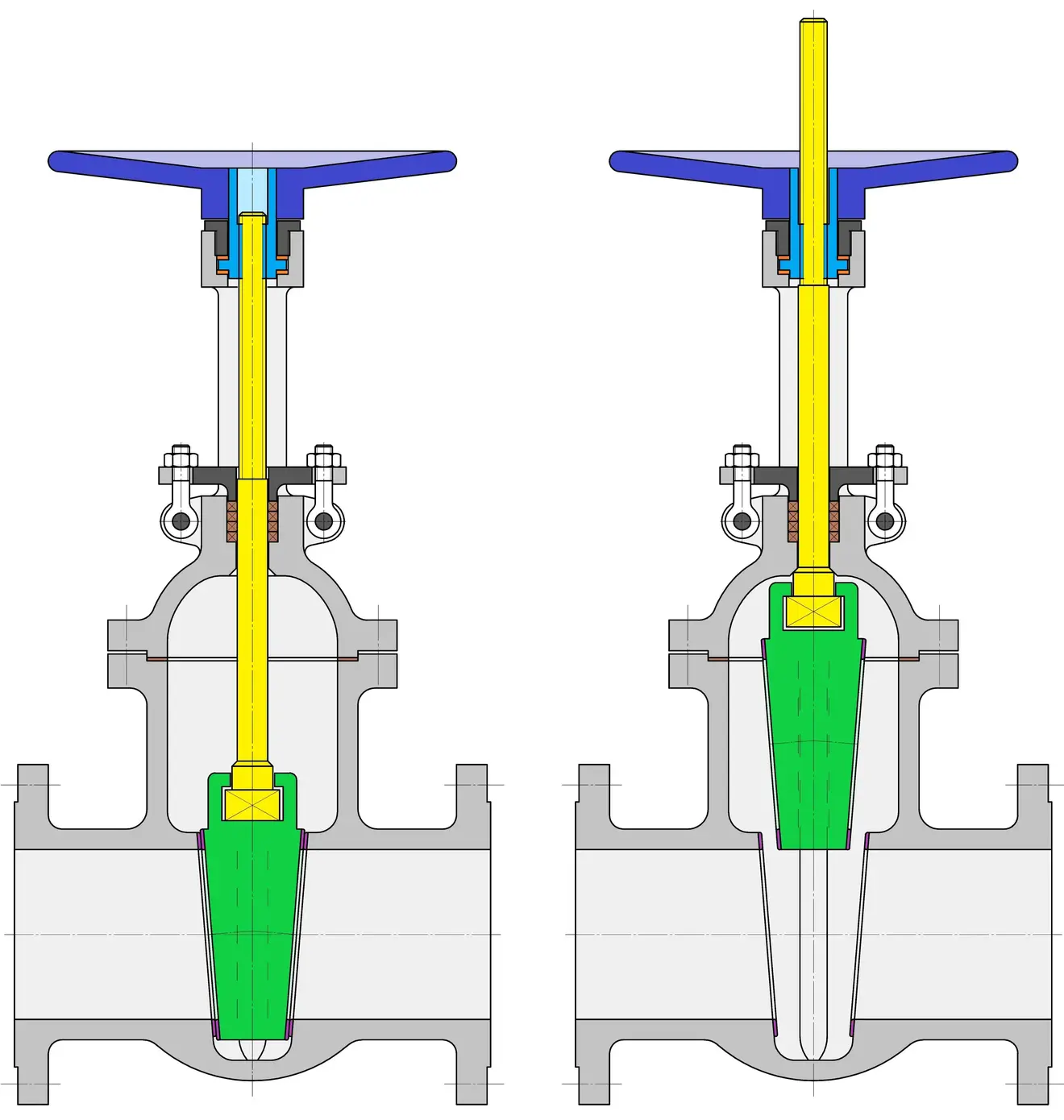
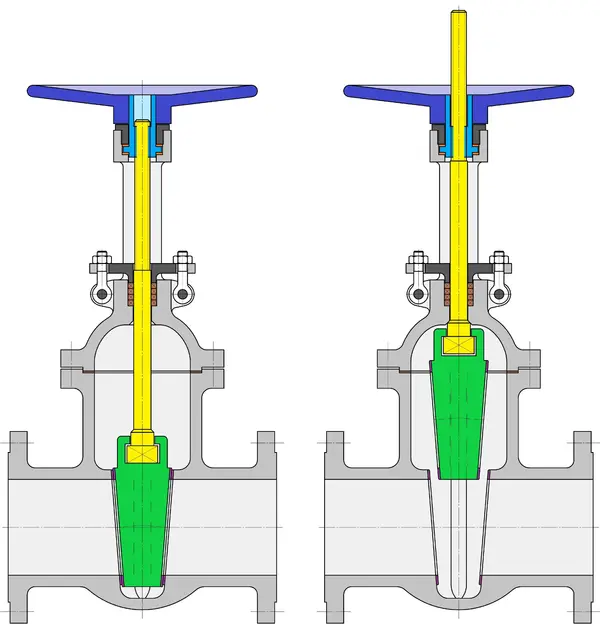
External (rising) spindle,
metal sealing
Rising / non-rising spindle
Rising spindle = always external, see above
Non-rising spindle = always internal, see above
Types of Shut-off Wedges
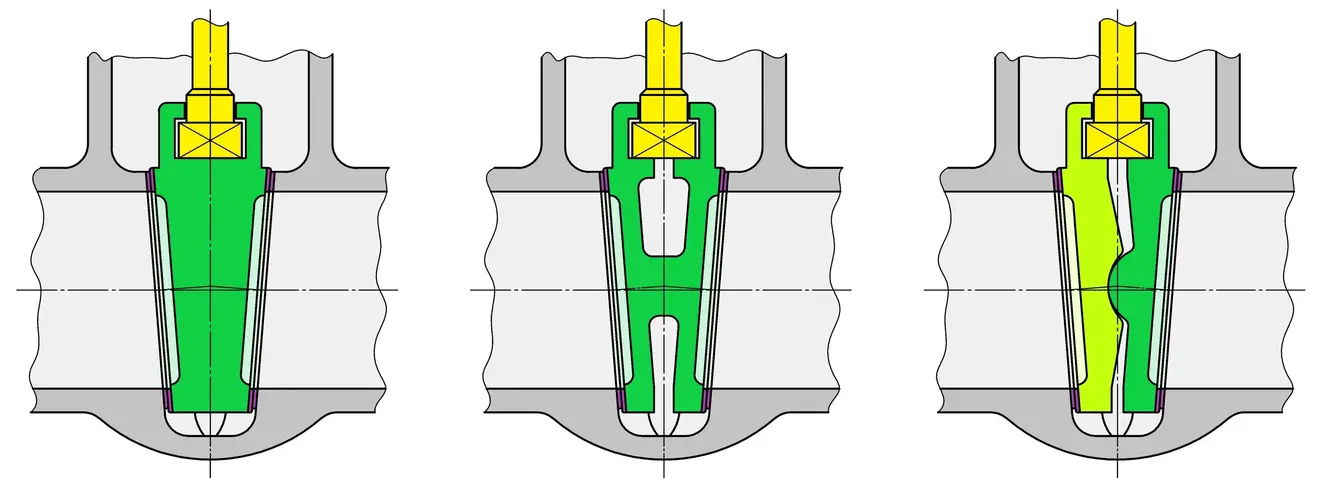
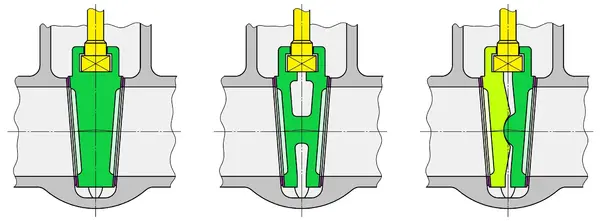
Stiff wedge
The shut-off element of a gate valve is wedge-shaped and typically consists of two connected plates.
If the two wedge plates are firmly connected (welded), they are completely immobile, and we refer to this as a stiff wedge. Both wedge sides and the "counterparts" in the housing, the housing seats, must be machined very precisely and flat to ensure a secure sealing of the valve against the medium.
In small gate valves below DN 40 and in very large valves, the stiff wedge is usually made from a single piece (forged material, casting). It is particularly heavy and cumbersome in large nominal sizes, thus correspondingly cost-intensive.
Flexible wedge
In the flexi-wedge, the two wedge plates are not rigidly connected but are only connected by a bridge in the middle. This allows the two plate halves to be elastic (flexible) within a certain framework and thus adapt more precisely to the housing seats. The achievable tightness is considerably higher than that of a valve with a rigid wedge.
Due to its good sealing properties and low weight, valves are mostly produced with a flexi-wedge today.
Exceptions include the soft-sealing valves, which are primarily used in the water/wastewater sector. In these valves, the rigid wedge is completely vulcanized with NBR or EPDM, achieving a high level of tightness.
Double plate wedge
The two sealing plates are movably connected to each other, e.g., by ball segments or spherical shells or via a spring mechanism. Since they are self-aligning, a high degree of tightness is achieved, and the gates can be opened and closed with less force. Due to the elaborate and cost-intensive manufacturing process, double plate gate valves are almost exclusively used for high-pressure applications in power plants as main shut-off valves at the main steam outlet or at steam generators.
Metallic sealing gate valves
The classic shut-off valves are very versatile: for liquid and gaseous media, as well as for media contaminated with dust or hard particles, for aggressive or abrasive media, in high-temperature and high-pressure applications. Of course, the materials used and the design (internal or external spindle) must be matched to the respective operating medium.
In all metallic sealing gate valves, the sealing seats/sealing rings in the housing and on the wedge are made of metallic materials. To achieve higher sealing capability, abrasion resistance, and/or corrosion resistance, sealing rings made from a variety of materials can be used.
A major disadvantage of metallic sealing gate valves is that impurities present in the medium (e.g., sand, lime) settle in the lower part of the housing (the valve pocket). These deposits can prevent the wedge from closing completely, which then leads to a leakage.
Stellite Seat
Stellite™ is a hard alloy based on cobalt-chromium and serves as protection against high wear loads from the operating medium. In the gate valve, the housing seats and, if applicable, the wedge and the spindle are stellited when exposed to aggressive media or overheated steam. Without protection, standard materials such as 1.4021 or 1.4571 would not withstand the high loads for long. This coating can be applied using weld overlay or thermal spraying.


Soft sealing, rigid wedge,
non-rising spindle
Soft-sealing gate valves
Soft-sealing gate valves are mainly used in the field of water/wastewater. Since the spindle is sealed maintenance-free by O-rings, soft-sealing gate valves are also suitable for use with gas (natural gas, biogas).
In contrast to classical, metal-sealing gate valves, they have a smooth, full passage without a valve pocket. This offers the advantage that the valves are piggable and the pipeline can be completely cleaned if necessary. A so-called pig is a cleaning or inspection device that is pressed through the pipeline using pressure.
Another advantage is the high tightness of the valves in the passage. The valve wedge is vulcanized with NBR or EPDM, achieving a tightness according to DIN EN 12 266-1, leakage rate A! Furthermore, these valves are conditionally suitable for vacuum.
Due to the rubber coating, soft-sealing gate valves are not suitable for high temperatures, high working pressures, or abrasive media. Like all gate valves, they are suitable "only" for shutting off a pipeline, not for regulating the operating medium.
Screwed / welded cover
This refers to the manner in which the gate valve body is connected to the upper part.
In the case of a screwed cover, as the name suggests, the body and upper part are screwed together. The connection is removable, allowing for the internal components of the valve to be serviced or replaced at any time for maintenance or repair purposes.
If a valve is only hard to access or is to be installed underground, the variant with a welded cover is usually used. This prevents unwanted loosening of the cover screws, e.g., due to vibrations during operation, thermal expansion, wear of the cover gasket, etc., and ensures tightness to the outside. In the case of repair or maintenance, however, the fitting must be completely removed from the pipeline and the cover connection must be separated in a workshop.
Drive Types
The classic drive type for gate valves is the handwheel. The international standard is that the gate valve is closed by turning the handwheel clockwise and opened by turning it counterclockwise.
Additionally, the following actuation types are available:
Gear with Handwheel:
If the required actuation forces are too high, a reduction gear with a handwheel can be used.
Quick-Closing Lever:
Instead of the handwheel, a bearing block with a lever is attached to the upper part of the gate valve; pulling upwards opens the gate valve abruptly, while pushing down on the lever closes it.
Chain Wheel:
If the gate valve is installed at a greater height, a chain wheel can be used for actuation. A chain is placed over the chain wheel and secured with a guide bracket to prevent it from falling. By pulling on the chain, the gate valve can be opened or closed from the ground.
Operation Key:
Instead of the handwheel, a square is attached to the end of the gate valve spindle. The gate valve can then be actuated with a jaw wrench or (when installed underground) from above with a T-key.
Automatically actuated valves
Electric drives:
Electric actuators can be precisely tailored to the requirements of the valve and can be operated optionally with three-phase current, alternating current, or direct current. Although they are expensive to purchase, they have a long service life and only low maintenance costs (easy installation, no energy consumption during switching pauses, maintenance-friendly). The switching times can be variably selected to suit the application, ranging from about 20 seconds to several minutes.
Pneumatic drives:
They are operated with compressed air, are cheaper than electric drives, have short switching times, and are maintenance-friendly. However, a compressed air supply and a solenoid valve for control are required.
A distinction is made between double-acting and single-acting pneumatic drives.
Double-acting means the drive requires compressed air to open the valve and also to close it.
Single-acting means that the compressed air is required either to open or to close. The resetting then occurs automatically via a spring.
Hydraulic drives:
The same principle as with pneumatic drives. However, these drives are operated with oil or water-based liquids (hardly flammable).
Remote-operated Gate Valves
The gate valves cannot always be operated directly at the installation site, e.g., when installed in a shaft, underwater, or in the ground. The operation is then performed manually via a drive rod or a screw extension or by an electric, pneumatic, or hydraulic drive. Depending on the structural conditions, it may be necessary to additionally install deflections with two or more universal or ball joints, as well as a vertical column with a handwheel or drive.
Installation Set
Water and wastewater pipelines, including their gate valves, are often installed underground. To operate the gate valves, an installation set is used. The installation set consists of an extension rod that is firmly connected to the gate valve spindle. To protect against contamination from seepage water and the surrounding soil, the rod is covered by a PE pipe. The upper end of the extension is equipped with a square the so-called T-key, which is used to operate the gate valve. A road cover forms the ground-level closure as well as the visible indication of the installation set located underneath.


Would you like personal advice?
Direct Contact
Do you have questions about our products or services? Would you like a personal consultation on a specific issue? Don’t hesitate to contact us directly! Our experts are here for you and look forward to assisting you.